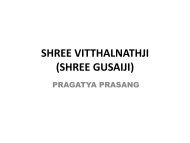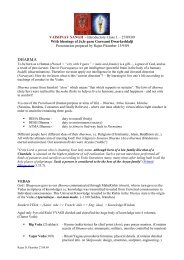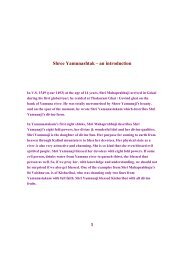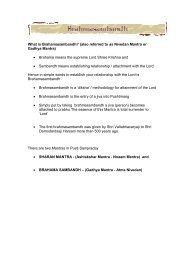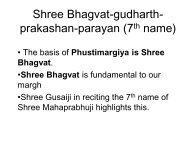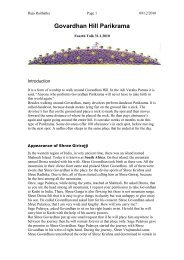View Document - VaishnavSangh.org.uk
View Document - VaishnavSangh.org.uk
View Document - VaishnavSangh.org.uk
You also want an ePaper? Increase the reach of your titles
YUMPU automatically turns print PDFs into web optimized ePapers that Google loves.
By Dhirajlal Pitamber , 12 th December 2010Answers to Question raised to Jai JaiShri Dwarkesh Lalji Bawa DuringSatsangh on 9 th July 201009/12/2010 1
LETTER TO THE EDITOR 619only modestly lower than that of 75 years in theUSA [4]. Another way to assess survival indirectly isto consider the frequency of haemophilia in differentcountries, as the incidence of haemophilia issimilar in different populations [5]. According tothe World Federation of Hemophilia global Surveyin 2005, there are only 1.1 persons with haemophiliaper 100 000 in the population in India, whichis only 21% of the value of 5.1 persons withhaemophilia per 100 000 found in the USA [6].This further suggests that people with haemophiliahave a reduced lifespan in India, although itremains possible that this difference could reflectreduced diagnosis or population differences.Another factor to consider is the morbidity ofhaemophilia in different countries. A report onmusculoskeletal function in people with haemophiliain India with a mean age of 14 years and a rangefrom 7 to 40 years demonstrated that although mostpeople could perform activities of daily life such aseating and dressing, many required assistance, and29% were unable to run [7]. In contrast, a recentstudy performed in the USA demonstrated that 93%of boys with haemophilia A who received prophylaxiswith factor VIII had normal joints by radiographicanalyses at 6 years of age [8], and it is likelythat such a dramatic improvement in joint diseasewill be maintained with continued prophylaxis.However, this was at a cost of $300 000 per year[8], and only 17% of patients in the USA receivedprimary prophylaxis prior to 2006 [1], which wasin part because of health insurance issues. A differentstudy found that 79% of people with haemophiliain India who were older than 25 years wereseverely disabled, and 51% of people who wereolder than 18 did not work [9]. Thus, althoughfrequent administration of high doses of factor VIIIcan reduce joint disease, most people in economicallydisadvantaged countries and a few people indeveloped countries do not have access to thisvery expensive treatment, and suffer substantialmorbidity.Dr Kimmelman states that it is unethical to recruitsubjects from economically disadvantaged countriesinto clinical trials for haemophilia primarily becausethey may not have access to gene therapy in thefuture. However, if patients from developing countriesparticipate in these trials and a successfultherapy does develop, it may be reasonable to expectthe sponsors or manufacturers of these products tomake them available in countries with emergingeconomies at an affordable cost. In addition, as thescience of gene therapy develops, it is possible thatscientists and biotechnology companies in thesecountries may themselves manufacture products f<strong>org</strong>ene therapy. It is certain that no potentially curativetreatment will be available if these trials do notprogress.There is an old Native American saying that youcannot know a man until you walk a mile in hismoccasins. Anyone involved in ethical decisionsregarding gene therapy for haemophilia should atleast watch people with haemophilia walk a mile(or in some cases attempt to walk, but fail becauseof joint disease) to have an inkling of the benefitthat would derive from a simple, long-lasting andeffective therapy. Nevertheless, none of us withouthaemophilia can truly understand the daily physicaland psychological challenges that face someonewith a deficiency of a coagulation factor, and thedecision to participate in a clinical trial should beleft to each individual after the regulatory agenciesare satisfied that there is a reasonable assurance ofsafety, and after providing the person with haemophiliawith appropriate information on the potentialrisks and benefits. Many clinical trials are open toeligible individuals worldwide. With access toinformation as it is today, is it fair to deny accessto a person with haemophilia who wants toparticipate in such a trial if he understands itslimitation? To imply that including patients whohave treatment responsive disease (Ôstable subjectsÕreferred to in this paper) but who still volunteer toparticipate in phase I trials is ÔtradingÕ on theirhopes for a cure is perhaps an insult to both thephilanthropic patients and the physicians, andindeed the entire medical team involved in obtainingconsent from the subject and conducting thetrial. One has to accept that there are individualswho most willingly participate in clinical trialsunderstanding fully well that they may not benefitfrom it.In summary, we believe that people with haemophiliain both developing and developed countrieshave something to gain either for the individual orfor the group by participating in gene therapy trials.Dr Kimmelman underestimates the burden of haemophiliaas it is currently managed and thus thepotential benefits from gene therapy, particularly indeveloping countries, although there are certainlysome risks involved. We do, however, stronglyconcur with the need to proceed as carefully aspossible, and to provide patients with as muchinformation as is available including the magnitudeand duration of the benefit of gene therapy in animalmodels, the frequency of observed adverse effectsand potential long-term effects that have not yet beenobserved in animal models.Ó 2008 The AuthorsJournal compilation Ó 2008 Blackwell Publishing Ltd Haemophilia (2008), 14, 618–620
Many people , Specially the older generation of the Pustimargya …believe and insist that the ‘Pushtimarg’ followers SHOULD NOT PAYRESPECT OR BOW DOWN TO Deities OTHER THAN Shri Nathji- Shri Krishnais this a correct understanding and assumption ? Answer : Bhagvat Geeta – Chapter VII – Verses 21,22,23 & 24:Shri, Krishna says to Arjuna:In whatever FORM any person desires to Worship WITH FAITH I make hisfaith firm and unflinching. The worshippers of the Devtas go to the Devtasbut My devotees Come to Me. Men of little-intelligence think of ME , theUn manifest , as having come to Manifestation… They do not know myHigher, immutable, peerless, shapeless, Nature.Comment on above verses:From the above words of Shri Krishna Bhagwan , we realise that , VashudevaShri Krishna is the Supreme God Head , and in our Pushtmargya faith , wehave surrendered to HIM, Shri Krishna, Shri Nathji .We have taken “Bhrma Samandha” vows and have there by surrendered ourbodies & souls to Shri Nathji’s Charan .Therefore our prayers should be to Him , Shri Krishna, Shri NATHJI TheSupreme God .this does not mean that we should not respect other Deities ; We shouldrespect and bow down to deities of Sanatan Dharma as well because theyare Avtars or Characters from our Scriptures.09/12/2010 3
Mahaprabhuji words reached theheavens and at this instance aMiracle happened from the depth of the Yamuna River, a G<strong>org</strong>iousbeautiful, sixteen years of age,Beauty appeared. She is Described as ‘ Megh Shyam Varnama – A female figure of a cloudy blue (MeghaVarnam) Celestial Beauty. Her face, Glittering , Shining , smiling andoverflowing with Sweetness. Her eyes as beautiful as Lotus flowers and fullof Love ; Her Cheeks Pink as roses. She had Female features but her garmentsdress were of a male Dressed in Yellow Chunni , red & green Dress ,wearing a Diamond & Rudy crown on Her head,with Peacock shaped Ear Covers , her neckgarlanded with a necklace of diamonds, rubies,and emeralds, ‘Janjars’ on her feet , andBracelets on her arms . On Seeing this vision, the Disciples, andMahaprabhuji himself , were numbed; Theystood bewildered with un-blinking , gazing eyes.09/12/2010 5
A 4: When we greet any person , that person has togreet us back and respond to our greeting . For example we greet one another and say ‘Kem Cho ?’.. He will say … ‘ Maja Che’ . If we were to greet a Pushti Marya Bawashri ,with the sentence Jai Shri Krishna , He willhave No response to that Because THE GURU HIMSELF IS THE ONE WHOIS PREACHING AND TEACHING US “ KIRSHNA BHAGWAN JAI CHE Moreover , it is a norm in Hindu teachings thatwe bow down, and touch the feet of respectedpersons , an elders , and bow down to theGuru’s feet [ Guru’s Charans] to seek theirBlessings their Aashirwaad. For this reason only, when we see or meet aBawashri , we should greet him by bowingdown to their feet and Say AAP NE DANDWATPRANAM which means I BOW DOWN TO THEEHis reply will be ‘AASHIRWAAD’ , meaning mayour blessing upon you. “Dandwat’ – is a word derived from ‘Danda’, along stick or a pole. This is to express to theGuru that .. I am bow down prostrated on the floor withmy body straight as a Danda .09/12/2010 8



